You might have a few customers who you notice often share your social media updates.
Or you may have some customers who mention they’ve told friends about your business, bringing in new customers for you.
But have you ever thought about how you can use your email list to find your best customers?
Your email subscribers have opted-in to learn more about your business. They’ve expressed interest in the products and services you offer, and many of them are likely opening, reading, and acting on your emails on a consistent basis.
By digging into your email list and using the information you have available, you can identify the people who are most interested in your business and look for opportunities to strengthen these customer relationships.
Here are 7 simple ways you can look to your email list data to tap into your best customers.
1. Opens
Who opens your emails the most? Data from Constant Contact revealed that 51 percent of all opens come from 10 percent of openers.
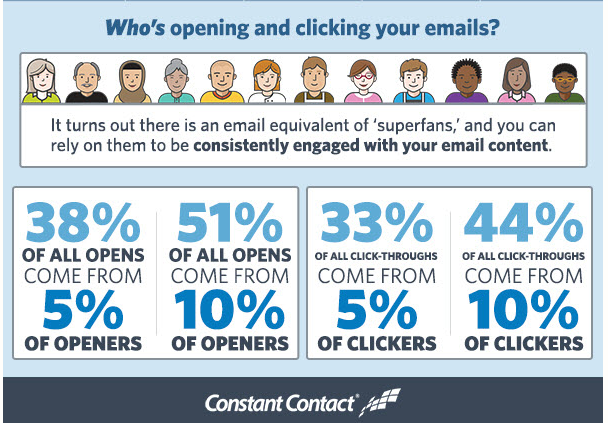
These are the people who are most interested in what you have to say and have the potential to become loyal advocates for your business. You can find out who these people are in your Constant Contact account by visiting the Reporting area and viewing the contacts that have opened the most campaigns recently.
Start with these people. Who are they? What were the topics that got them to open? Consider following up with additional information and look to extend the relationship beyond the inbox.
2. Click-throughs to product introductions or features
Once you find out which people are opening your emails the most, take a look at which customers are consistently clicking through to the content you put in your emails. This could be a blog post about a new product or service you’re offering or a customer testimonial.
There’s a good chance many of these people have already made a purchase or signed up for one of your services, consider reaching out to them with an online survey or a special offer to further that relationship and learn more about what they’re most interested in.
Take that step even further by learning how to Create More Targeted Lists Using Click Segmentation from our knowledge base.
3. Website or social media clicks
If you include links to your website or social media accounts in your email campaigns, check out who clicks on these links.
These customers are likely interested in learning more about you or connecting with you through multiple channels.
4. Coupon redemption
It’s always a good idea to include a measurable action for your readers to take.
Adding a coupon that people can redeem online is a great way to identify people who are not only clicking through to learn more, but are actually taking the next step to redeem an offer.
Look for opportunities to follow up with these people with reminders and other offers to bring them into your store.
5. Social follows
If you’re using email to promote your social channels, look to see who is taking the next step to like your Facebook Page or follow your updates on sites like Twitter, Instagram, or LinkedIn.
This group is a great community to tap to ask for testimonials or quotes to put on your website and to collect photos for use across your marketing.
6. Event registrations
Do you host events for your company? If so, you should be using your email list to promote them.
Knowing whether someone has attended a couple of your events can be helpful for knowing that they’re interested in attending future events like store openings or holiday celebrations, bringing friends to your events and introducing you to new customers in-person.
And while online referrals are easy and effective, in-person referrals carry even more weight.
7. Blog post shares or comments
You may not be able to tell this one from your email list, but it’s another good, online way to figure out which customers care the most about your updates. This group of people (even if it’s a small group) is vocal and clearly willing to share your updates and news, and will not be afraid to give you opinions on your business.
Find your brand advocates today.
By starting with your email list and doing a little bit of simple analysis, you’ll be on your way to asking these involved, devoted customers to help increase the power of your marketing in no time!
When you reach out specifically to your “best” customers, you may uncover some customers that have purchased from you a few times, and are really happy with the experience they’ve had with you.
These are the people who will be open and willing to share your message with new customers in their networks and help you grow your business.
Have you spent any time looking into your email list to find your best customers? I’d love to hear your best advice.
About the author: Ali Hyatt leads marketing and product for Upward Labs, which creates software for businesses to build and manage brand ambassador programs to drive customer engagement and increase revenue and reach.
Making sense of your email marketing analytics can be tricky at first.
How do you know which numbers to focus on? What do all those numbers really mean anyway? Is this really worth your time?
To approach your email reports with confidence, you have to understand what information you have available from your email campaigns and how to use that information to improve your marketing strategy.
Let’s take a quick look at six of the most important things you can learn from your email analytics:
Not a Constant Contact customer? Start your free 60-day trial today.
1. Who read your email?
Within your email reports, click on the number of people who opened a particular email. This takes you to a list of email addresses of all the people that opened that email campaign, as well as the time that they opened it.
You can also see your open rate, your average open rate, and how you compare to others in your industry. These are key metrics to your campaign tracking.
As you can see in this example, from River Rock Climbing, their December 2015 newsletter received a 35 percent open rate — a nice jump from their average of 17 percent.
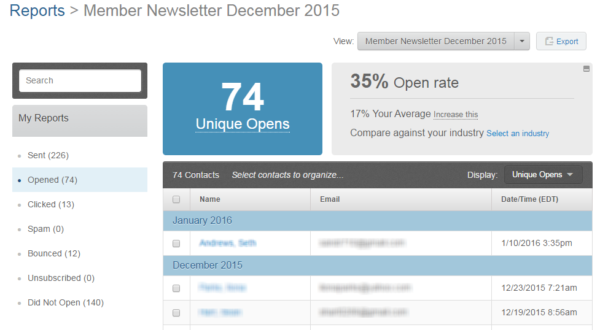
Next steps: After looking at their email opens, River Rock Climbing knows which people are actively engaged. As a next step, they could tag these contacts and follow up with another email to provide a special, such as a class discount. By rewarding their most loyal members, they’re providing a good incentive for taking action.
2. What did your subscribers find interesting?
Next, take a look at the “Clicked” tab. This will show you how many clicks your email received, your click-through rate for this email campaign, your average click-through rate, and how you compare to others in your industry.
This is a great indicator of what information is most interesting and relevant to your audience.
River Rock Climbing received 13 unique clicks in this email, generating an impressive 18 percent click-through rate.
From the information below, you can see that a YouTube link received the most clicks — indicating that video content resonates well with their audience.
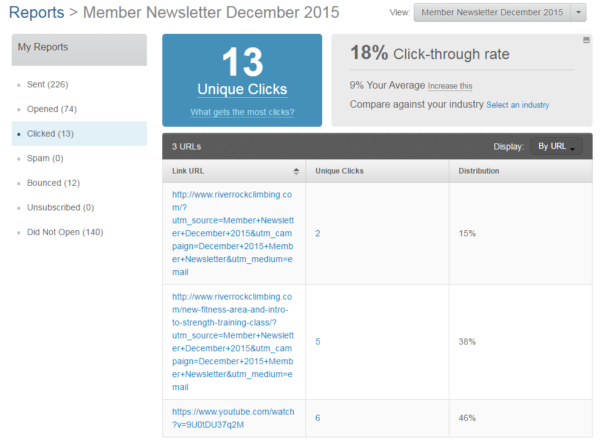
Next steps: Your email clicks can help guide the content you create. Notice what topics and types of content are getting the most attention from your audience and continue to send information that’s tailored to your audience’s interests.
You can get an extremely targeted email list by following up with people who clicked on a specific link. For example, if the YouTube video was about a climbing instruction class, River Rock Climbing could reach out to the six people that watched the video with information about an upcoming class.
This helps River Rock Climbing move people through the buyer’s journey and move them closer to taking action and making a purchase.
3. When’s the best time to send your email?
As mentioned above, you can see when your email subscribers are opening your emails. Take a quick look and make sure your sending schedule is in line with when most people are opening.
You can Find the Best Time to Send an Email using industry trends and best practices that have worked for other businesses.
Next steps: Once you find a time that works well, be consistent so your audience starts to expect your emails. You can even create the expectation right at the point when a new contact signs up. If you always send emails on Friday morning, let your subscribers know by telling them in person and in your online sign-up form.
4. On what device are people reading your email?
You already know that more and more emails are now read on a mobile device. But these metrics also vary, depending on your audience.
Visit the “Campaigns” tab to see how many people are opening your emails on desktop versus mobile. The stats are consistently updated to reflect the data from your last five email marketing campaigns.
As you can see below, over 55 percent of River Rock Climbing’s email subscribers are opening from a mobile device.

Next steps: No matter what your exact distribution is, using a mobile-responsive template is key to ensuring your subscribers are getting the best experience. Use a mobile-responsive email template so your email adapts to whatever size screen it’s viewed on.
5. How can you do better next time?
As you start to dig deeper into your email analytics, it’s inevitable that you’ll find areas where you want to improve your data-driven marketing strategy. Below is a chart to help you identify some opportunities if you feel stuck.
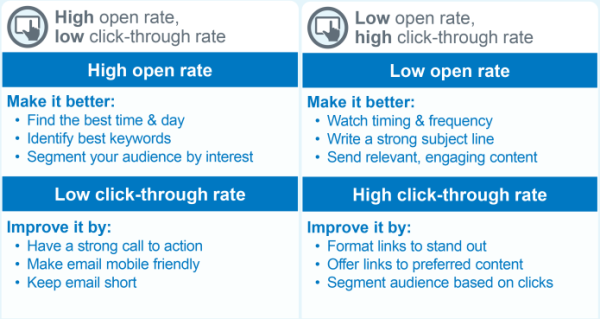
Two very common questions are: How can I improve my open rate? And How can I improve my click-through rate?
To increase opens, find that best time to send and be consistent with your delivery. It’s also important to craft a compelling subject line so you’re making a good first impression in the inbox and enticing people to open. Lastly, check in with your audience and make sure you’re sending them information they find valuable. Ask people in-person, or send an online survey, to better understand what they’re looking for.
Low click-through rates are usually an indicator that you need a stronger call-to-action. Tell your audience clearly what action you’d like them to take next — whether it’s to come into the store for an event, register for a webinar, donate, or shop online. Keep your information concise and make sure your message is clear no matter what device people are reading on.
Next steps: Improving your results is a learning process. Set clear benchmarks and work towards them. Your best bet is to stay focused and try to improve in one area at a time. Check out some of our top email marketing best practices here and choose one area to focus on.
6. Why is email marketing worth your time?
Without a strong grasp on your email analytics, this question might be a little hard to nail down. Sure, you know email is a good way to reach your audience, but how is your email marketing strategy impacting your business and bottom line?
Map your email efforts to a desired business result and track your success. If your business goal is to increase online shopping, look at your click-throughs and monitor you online orders. If you want to drive more donations during the holiday season, create a series of emails and total the contributions that come from your email subscribers.
Seeing your efforts pay off and understanding the specific impact your emails are generating will give you confidence in your approach and motivate you to do more with email marketing.
Email analytics, without the headache.
You don’t have to be an analytics expert to measure the impact of your email marketing efforts and the role this channel is playing in your overall digital marketing strategy.
Take some time exploring your email reports, choose one area you want to improve in, and check in after each email, tracking your results as you go.
Log in now to see how your last email performed.
Not a Constant Contact customer? Start your free 60-day trial today.
Imagine creating emails as satisfying as freshly-baked cupcakes.
Sounds good, doesn’t it?
Your readers would bite hungrily into your content. And wait impatiently until the next time you hit send.
Could an email ever be that good?
For Sarah Waters, brand director of Treat Cupcake Bar, email marketing is one of the most effective ways to pique her customers’ appetite and get them to shop with her.
“We’re the kind of store where people may only come in every other month, so we really need to be able to reach people through email,” says Sarah. “Email has definitely helped increase our online orders. People being able to click-through and shop online has been huge.”
Here are Sarah’s four ingredients of crave-worthy emails:
1. Start with an enticing sign-up experience
Since signing up for email marketing, Sarah has grown her email list to over 2,500 contacts. She collects contact information both online and in-store to reach her audience at multiple touchpoints.
Her sign-up form is visible on every page of her website — not just the homepage. She also uses the Join My Mailing List Facebook app so anyone who visits her Facebook Page can join her mailing list easily.
Here’s how the Join My Mailing List App appears on her Facebook Page:
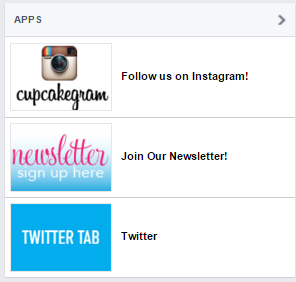
In-store, Sarah offers a small incentive to entice people to sign up.
“We have bowls in both our stores that ask people to ‘Sign up for the Friends of Treat Mailing List’,” she says. “When they sign up, they’re also entered into a monthly raffle to win a dozen cupcakes. “
Tip: Use this checklist to make sure you’re doing everything you can to build your email list.
2. Only send valuable information
With a growing list of subscribers, Sarah is sure to make every email count. Her emails include information on upcoming sales, details of store events, and creative solutions.
“We never want to put together a newsletter that feels like there’s no reason for it,” she says. “We always want to feel like we’re informing them of something new. We don’t want anyone to ever feel like we’re sending them junk or something they already know.”
Sarah emphasizes that her emails aren’t always promotional. Her advice for stand-out marketing is to simply understand your customers and what interests to them.
“You don’t have to always send out sales,” Sarah explains. “If you send out a creative recommendation (like a cupcake centerpiece) or unique gift idea that can be a breath of fresh air among all the special offers. We try to solve a problem for them or offer some inspiration.”
Here’s an email Sarah sent out to remind customers about Treat’s gluten-free options:
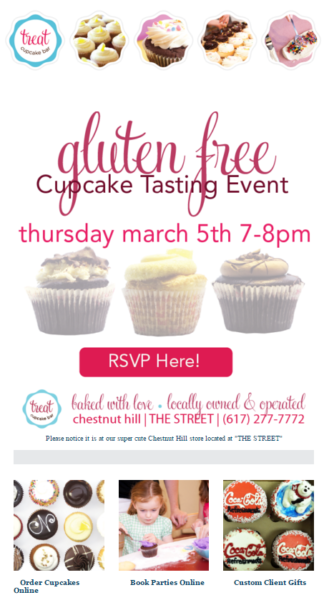
Tip: Use these 30 email ideas when you’re not sure what to send.
3. Be timely
Timing is a huge part of Sarah’s email marketing strategy. When deciding what to send, she thinks about what holidays are coming up and how Treat Cupcake Bar can fit in with her customers’ plans.
“I try to allot one day a month where I can think about what my game plan is going to be,” Sarah explains. “I plan things around the holidays — for example, I know around October and November I’ll need to send emails about Halloween and Thanksgiving.”
Working around holidays means Sarah’s messages are always timely and she is able to plan things out ahead of time.
“My advice is to write down your game plan ahead of time,” she says. “It saves me a lot of time to have a schedule with what kind of content I want to send out. And then it’s just sticking to that schedule the best you can.”
Sarah sent this email to promote custom orders for Thanksgiving:
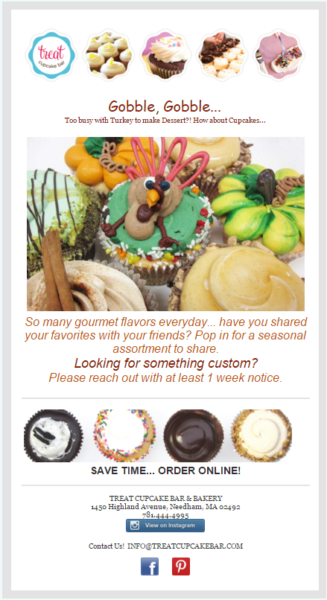
Tip: Here’s how to create an email marketing plan that you’ll actually stick to.
4. Keep emails short and sweet
A recent Constant Contact survey found that emails with approximately 20 lines of text and three or fewer images resulted in the highest click-through rate.
For Sarah, using a mobile-responsive email template allows her to create short and focused messages that are fast to create and easy to read.
“I want my emails to be clean. And I want, from the moment that someone opens it, for them to be able to see the purpose without scrolling down,” Sarah says. “I’ll add a cute, whimsical header, a big picture of something that makes them hungry, and just a line or two about what the email is about.”
Sarah makes sure the main picture links back to her website and she always includes contact information and buttons to her social media channels.
The example below includes an engaging header, an image and short description, and a call to action to order online:
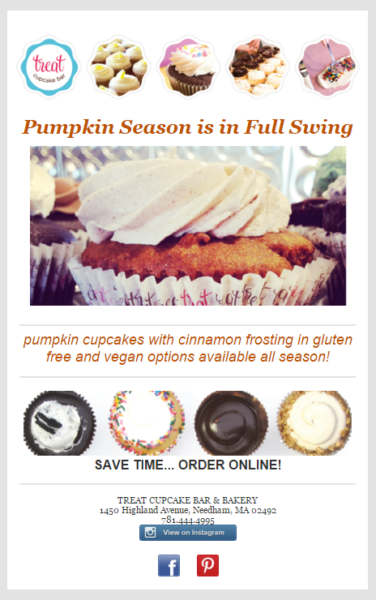
Tip: Use these steps to design emails to drive more action.
Make your readers hungry for your next email!
Using Sarah’s tips, you can create emails your subscribers are excited to consume.
Don’t bite off more than you can chew — choose one of these four tips where you think you can make the biggest improvement. Even small improvements can make a big difference and go a long way in building loyalty with new and existing customers.
Want to send business-generating emails in no time? Our 5-step Approach to Successful Email Marketing guide will show you how!
